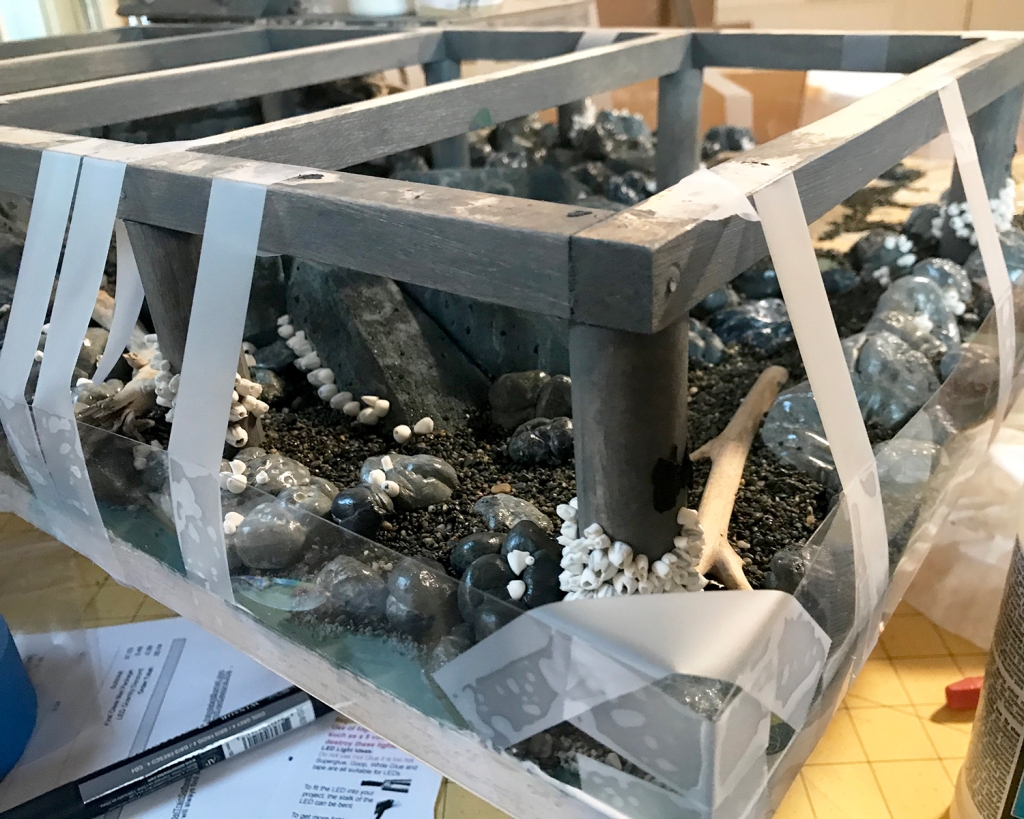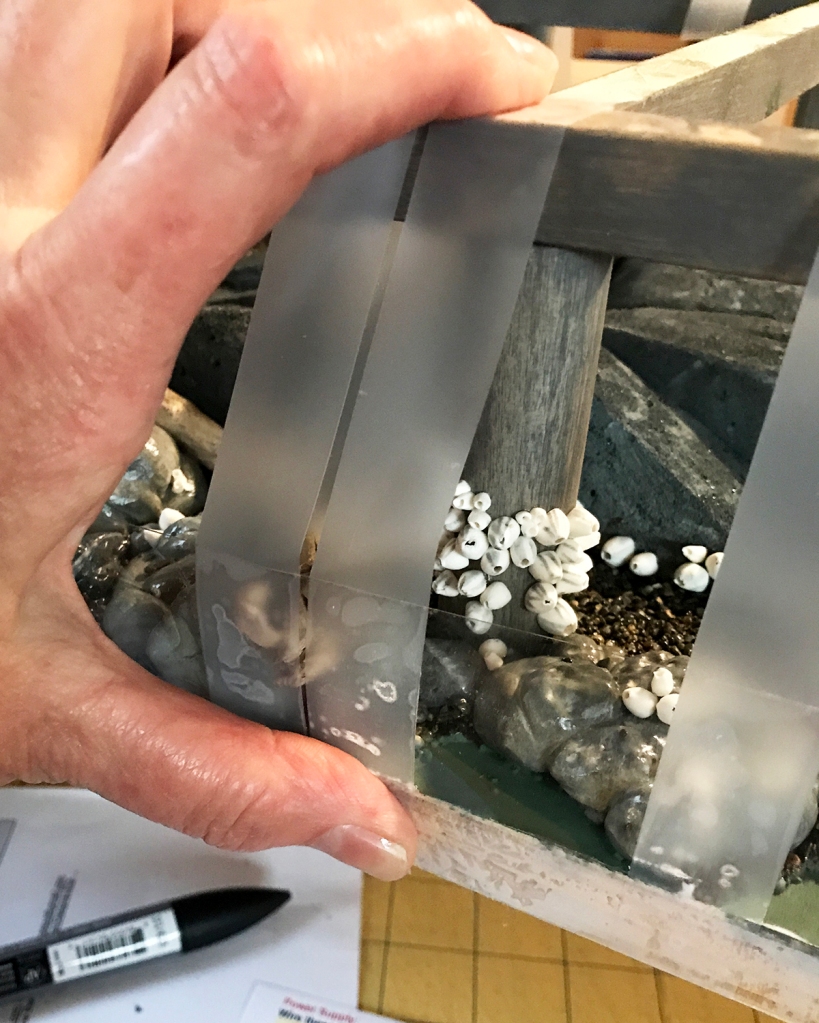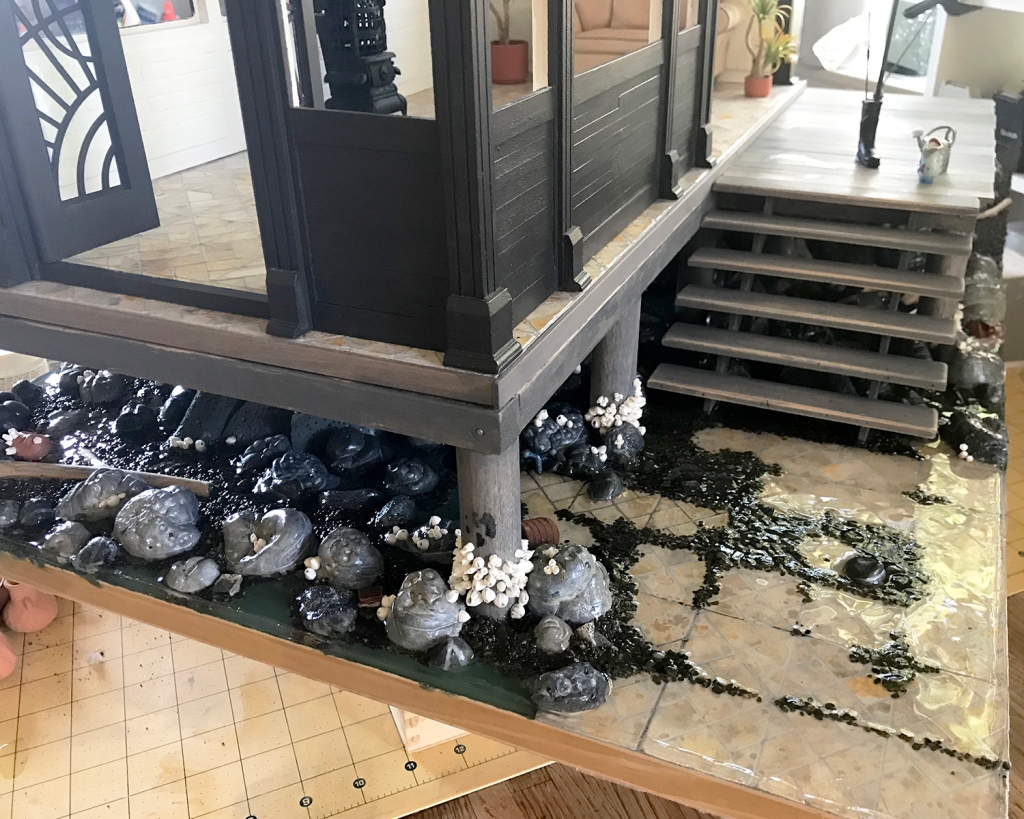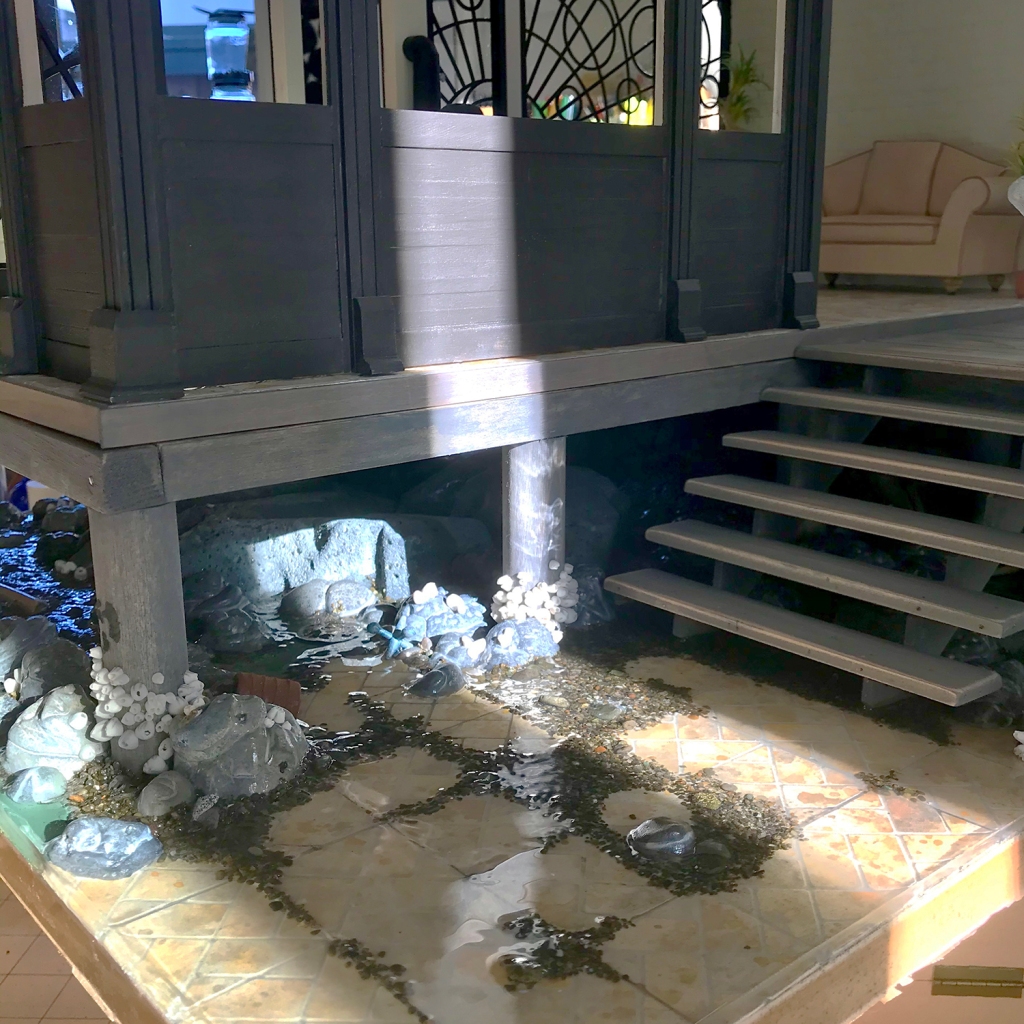
Although this photo was taken during high tide, this is the water feature look I want to emulate on the Sea House Conservatory low tide build.

After watching countless hours of video demonstrations from a variety of sources, I started my experiment with a small area at the front of the Leadlights landscaping that seemed natural for a water incursion. I glued a 2-inch tall length of acetate to the project board to form a dam, several inches longer than the intended 4-inch-wide pour, reinforced with masking tape below and tape holdfasts above.

Several deep breaths and I poured a scant quarter-inch of Realistic Water ™ from Woodland Scenics into the prepared area. Recommendation is an eighth-inch, but hey, it pours fast. So far so good.

I did the same prep on the Conservatory project board.

One tricky situation encountered is when any element of the landscaping extends past the base, even a little. I had some time to consider ways I will do it differently next time, as I held the acetate to the base while the glue set adequately.

When the glue seemed set, I boldly — yet delicately — poured the first course of water into the prepared base. Altogether, five or six individual glugs into each tide pool and basin.

Unsurprisingly, as I looked and marveled at the swampy effect and the no-going-back-nowness, a few small, very slow leaks began to develop. I used wide painter’s tape to further seal — more on that later — the acetate dam to the base. Checking again about two hours later I added more tape, and also noticed a few small areas where the glue I had used to cement the gravel and boulders to the base seemed to be turning opaque white.
Hmmm.
The recommendation for the water product is to let each layer dry at least 24 hours. It was very late by this time, so I called it a night very early morning and went to bed.

Next morning, not 24 hours later, I was encouraged to see the water was turning clearer, but the small white areas were still present, noticeably in the transition areas of gravel I had applied a few days earlier.

So I re-read the product label instructions.

Not for use with PVA glue. I’ll shorten my whole lengthy tirade — who doesn’t commonly use PVA glue? Why wasn’t this the very first caveat on the label, and why was this condition never mentioned in any of the company’s instructional videos on use of the product, etc… and lots of swears and unkind, rude assumptions and declarations. But then there was the offhand “Cure above 70°F.” Thankfully I have a wise and patient bitch buddy to vent to with whom I can vent. You know who you are are.
Then I calmed down enough to embrace that since there was nothing I could do about it now, I’d wait and see what would continue to happen. After all, it had not been even 24 hours yet, and it is a rather larger area and blah, grumble, blah.
I wasted more time did more research on pouring water, this time with a variety of mediums and preparation techniques, and even grubbed around in some forums, which I detest, and learned that yes/no there are some/not any problems with PVA glue that can be gotten around by sealing everything with — and here again suggestions vary — some sort of varnish, and, most valuably, some clever ways to build and seal dams for water feature success. One involved swamp water.
Time passed, and my watery problems with this product mostly resolved themselves. I continue to steep myself in the experiences of others.

I did a second pour on Leadlights, and a second and third pour on areas of the Conservatory. Above you can see the dam removed to reveal the fully cured water. (One of the plants bled a little color into the water, but I don’t mind.) I wanted a “live edge” to the water, and used an Xacto knife to carve away the lip. The project base itself will be edge-banded with thin basswood for a finished look :)

All in all, I am happy with and consider the results a success. I’ll know so much more on the next one.
Check out the light shimmer on the right pier piling, a reflection from the late afternoon light. Magical realism, which validates my efforts :)

I’ll leave you with this image found in Bolinas, on the estuary marsh/riparian transition on a winter afternoon hike at low tide. (Very low and long ago for this guy.)


I’m amazed by this. Now I really want to try water with something!
Yay Sheila! It’s really worth doing. Very little yields big results :)
Quite an adventure and learning experience with spectacular results, unfortunately there are no cats.
Hah, Joyce! Thank you for the props :)
And of course Scarlett was around, but I think this water product is *just* — no too — stinky enough that she kept her distance.
The water looks like water, so well done! I want to play around with glue waves, as demonstrated in the swamp tutorial.
Thanks, Keli. I thought the straw blow technique was brilliant, too, and worth the risk of hyperventilation. I saw another builder using it, with a coat of thick gloss Mod Podge, to create the first texture layer on a rushing river.
Most of all I admire your courage. All your beautiful creativity at huge risk of adding something that couldn’t be removed. I am in absolute awe. Seriously I might have set off thinking I would do that but I bet anything I would have chickened out but just see what some bravery will do. It is a lovely effect and worth the stress overload.
I *did* have to psych myself a bit, but really, I felt as prepared as is possible for me. The set up is key (of course) and waiting for things to cure is worse than waiting for glue to dry properly. If those (mostly) lads in the videos could do it, then so can I. And so can you!
Like lights, water seems to add life and movement to a build, well worth it.
It’s beautiful, what a risk to take, but so worth it! The back story and setting come alive with the addition of the water. Thanks for sharing your process, it might be just what I needed to get my fingers wet. Well not literally, as I’m sure that would make a mess and ruin the pour.
The water is gorgeous and adds realism and nowness (is that a word?) to your scene! Well done!
Many thanks, Shelley. Water really is like a character, and at the risk of being obvious, an elemental :) You can do it!
Nice job, it looks totally real. And you were very brave, I was almost holding my breath to see the end result. I like the hand clamp – maybe you can make and market them as a new tool. 😉
Thank you, Bennie. I do — or did — feel brave! I was more than a little amped up, which makes the hours and days of waiting more of a trial.
If only there was a functional, not-creepy Hand Clamp® available, I’d buy a full set.
You do make the most interesting “underneaths”.
Why thank you! “Interesting” is to me high praise :)